Strategic Information System: Enhancing Public Transport in Australia
VerifiedAdded on 2023/06/06
|7
|1452
|388
Report
AI Summary
This report examines the strategic information systems currently in place within Australia's public transportation sector, encompassing options like trains, buses, and subways. It highlights the transition to digital systems, including cashless payment methods, to improve efficiency and reduce fund mismanagement. The analysis identifies key services appreciated by commuters, such as accessibility, affordable fares, and competitive journey times. Weaknesses in the current system, including low comfort levels, long waiting times, breakdowns, and high travel costs, are addressed. The report proposes improvements through a modernized transport system flowchart and data flow diagram to streamline operations and enhance commuter experience. The goal is to make public transport a more attractive and reliable option, reducing reliance on private vehicles and mitigating urban issues like congestion and parking problems. This document is available on Desklib, a platform offering study tools and resources for students.
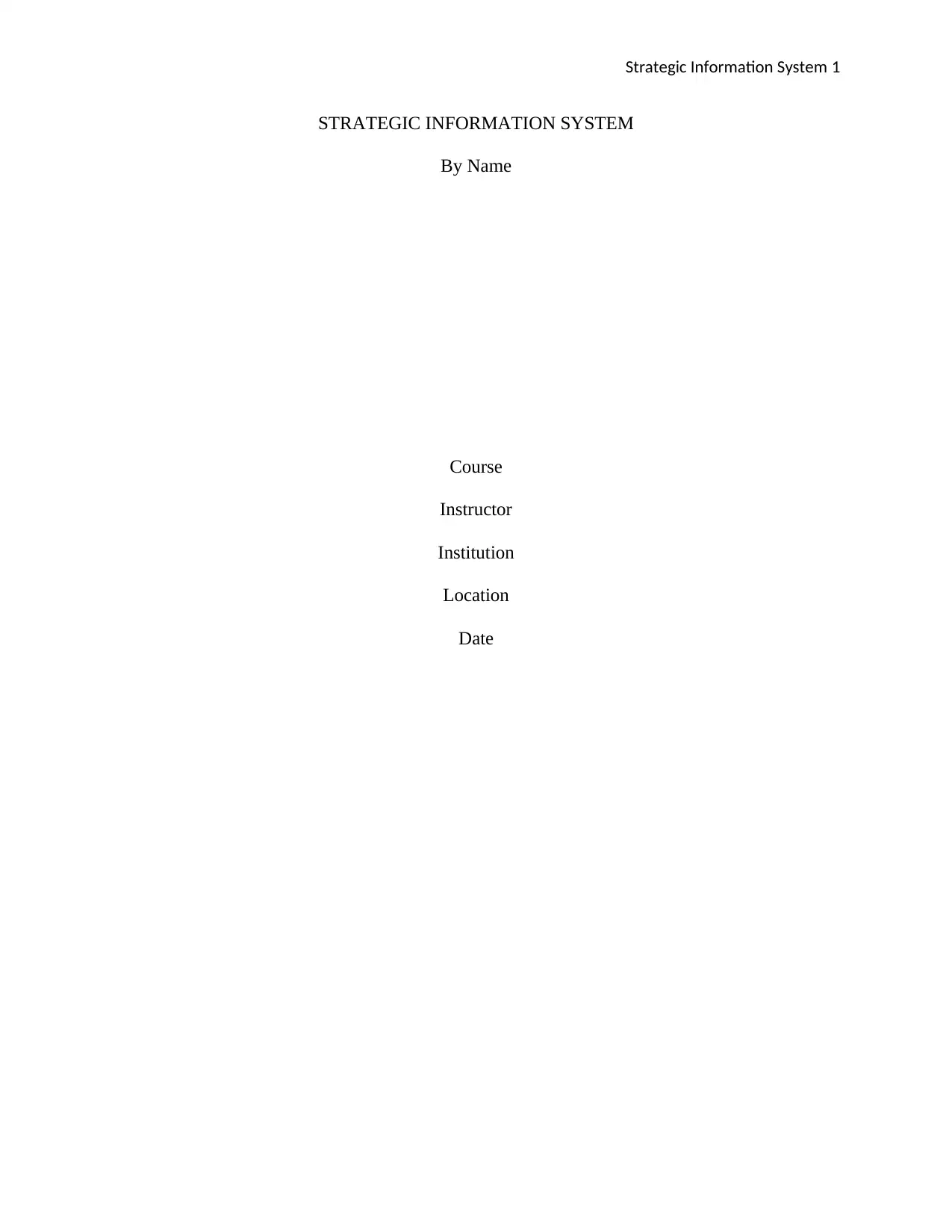
Strategic Information System 1
STRATEGIC INFORMATION SYSTEM
By Name
Course
Instructor
Institution
Location
Date
STRATEGIC INFORMATION SYSTEM
By Name
Course
Instructor
Institution
Location
Date
Paraphrase This Document
Need a fresh take? Get an instant paraphrase of this document with our AI Paraphraser
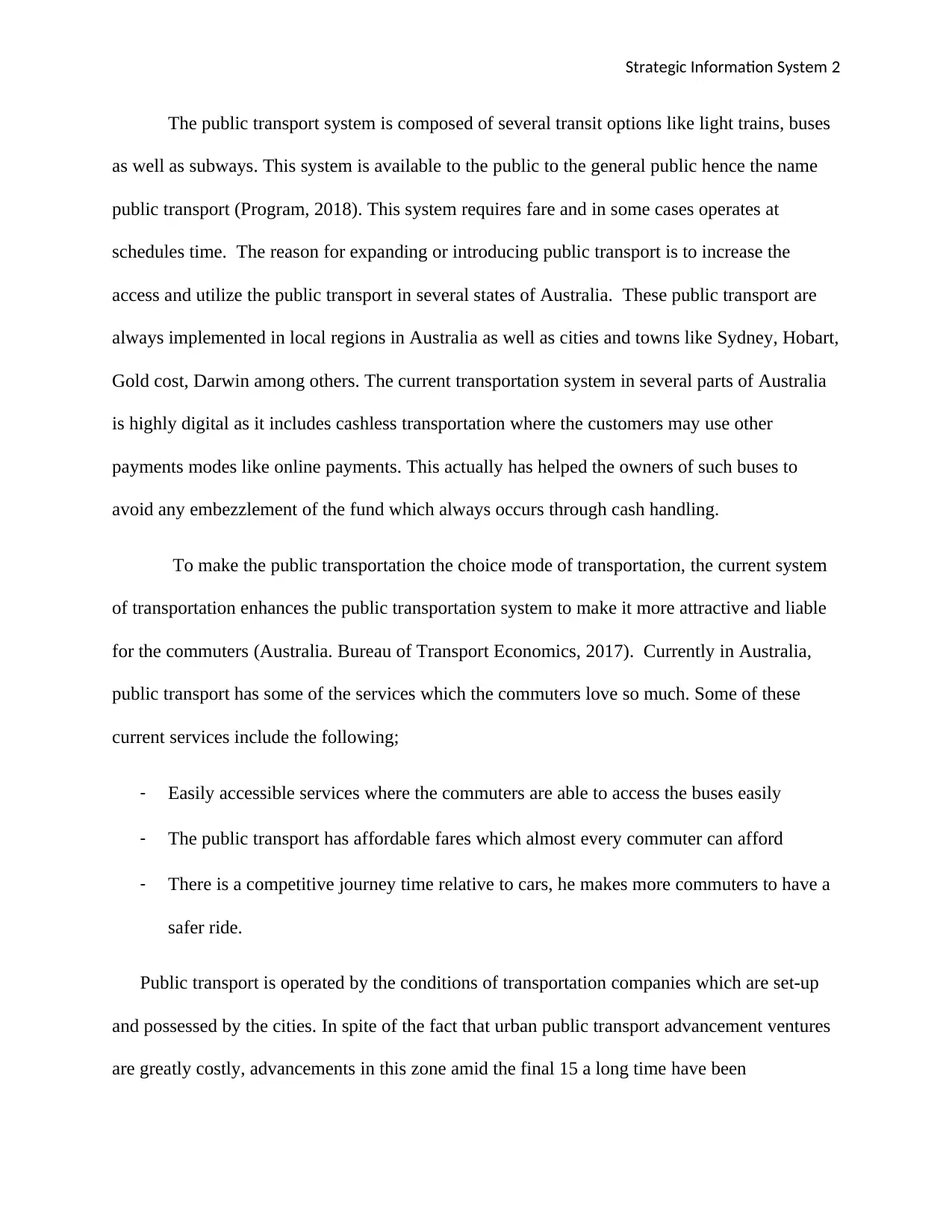
Strategic Information System 2
The public transport system is composed of several transit options like light trains, buses
as well as subways. This system is available to the public to the general public hence the name
public transport (Program, 2018). This system requires fare and in some cases operates at
schedules time. The reason for expanding or introducing public transport is to increase the
access and utilize the public transport in several states of Australia. These public transport are
always implemented in local regions in Australia as well as cities and towns like Sydney, Hobart,
Gold cost, Darwin among others. The current transportation system in several parts of Australia
is highly digital as it includes cashless transportation where the customers may use other
payments modes like online payments. This actually has helped the owners of such buses to
avoid any embezzlement of the fund which always occurs through cash handling.
To make the public transportation the choice mode of transportation, the current system
of transportation enhances the public transportation system to make it more attractive and liable
for the commuters (Australia. Bureau of Transport Economics, 2017). Currently in Australia,
public transport has some of the services which the commuters love so much. Some of these
current services include the following;
- Easily accessible services where the commuters are able to access the buses easily
- The public transport has affordable fares which almost every commuter can afford
- There is a competitive journey time relative to cars, he makes more commuters to have a
safer ride.
Public transport is operated by the conditions of transportation companies which are set-up
and possessed by the cities. In spite of the fact that urban public transport advancement ventures
are greatly costly, advancements in this zone amid the final 15 a long time have been
The public transport system is composed of several transit options like light trains, buses
as well as subways. This system is available to the public to the general public hence the name
public transport (Program, 2018). This system requires fare and in some cases operates at
schedules time. The reason for expanding or introducing public transport is to increase the
access and utilize the public transport in several states of Australia. These public transport are
always implemented in local regions in Australia as well as cities and towns like Sydney, Hobart,
Gold cost, Darwin among others. The current transportation system in several parts of Australia
is highly digital as it includes cashless transportation where the customers may use other
payments modes like online payments. This actually has helped the owners of such buses to
avoid any embezzlement of the fund which always occurs through cash handling.
To make the public transportation the choice mode of transportation, the current system
of transportation enhances the public transportation system to make it more attractive and liable
for the commuters (Australia. Bureau of Transport Economics, 2017). Currently in Australia,
public transport has some of the services which the commuters love so much. Some of these
current services include the following;
- Easily accessible services where the commuters are able to access the buses easily
- The public transport has affordable fares which almost every commuter can afford
- There is a competitive journey time relative to cars, he makes more commuters to have a
safer ride.
Public transport is operated by the conditions of transportation companies which are set-up
and possessed by the cities. In spite of the fact that urban public transport advancement ventures
are greatly costly, advancements in this zone amid the final 15 a long time have been
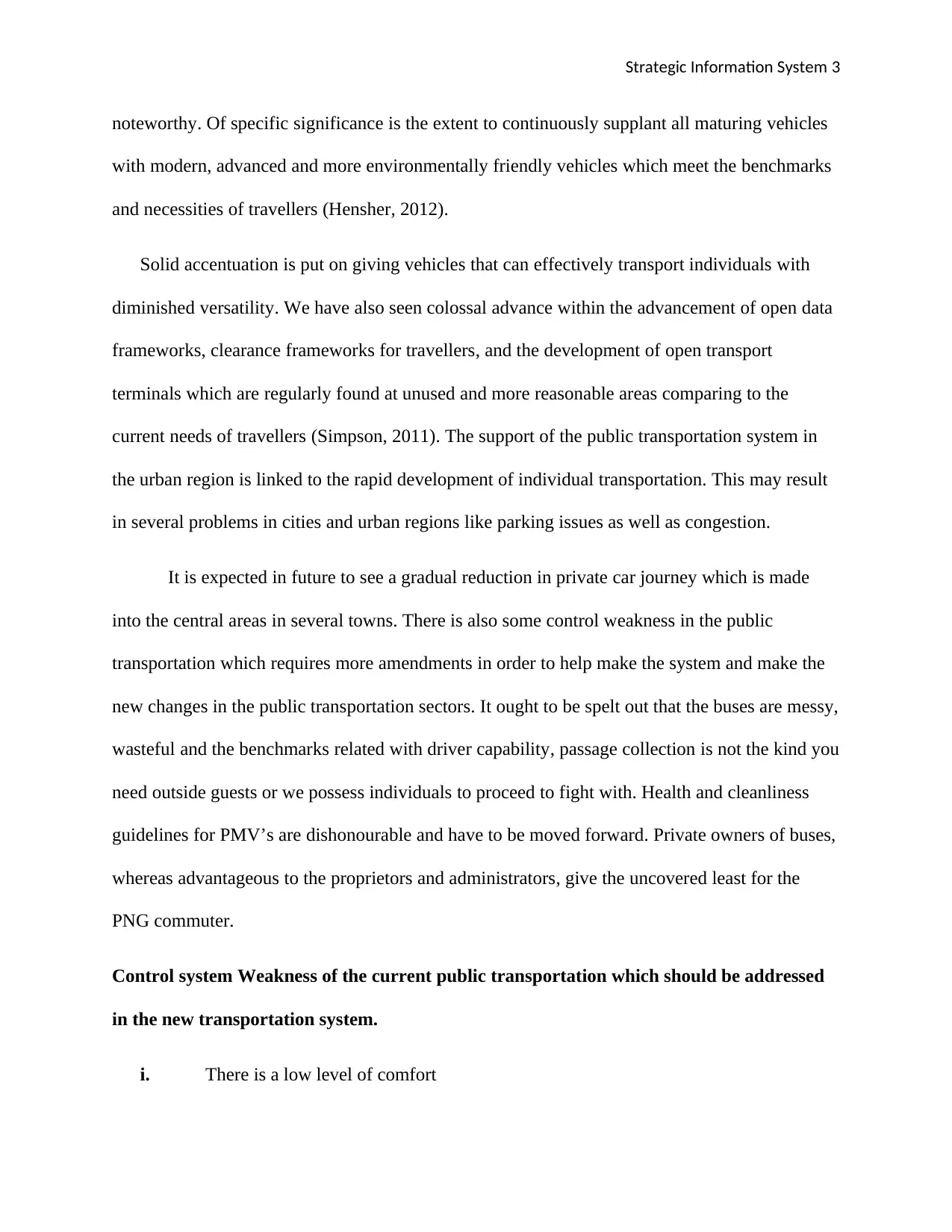
Strategic Information System 3
noteworthy. Of specific significance is the extent to continuously supplant all maturing vehicles
with modern, advanced and more environmentally friendly vehicles which meet the benchmarks
and necessities of travellers (Hensher, 2012).
Solid accentuation is put on giving vehicles that can effectively transport individuals with
diminished versatility. We have also seen colossal advance within the advancement of open data
frameworks, clearance frameworks for travellers, and the development of open transport
terminals which are regularly found at unused and more reasonable areas comparing to the
current needs of travellers (Simpson, 2011). The support of the public transportation system in
the urban region is linked to the rapid development of individual transportation. This may result
in several problems in cities and urban regions like parking issues as well as congestion.
It is expected in future to see a gradual reduction in private car journey which is made
into the central areas in several towns. There is also some control weakness in the public
transportation which requires more amendments in order to help make the system and make the
new changes in the public transportation sectors. It ought to be spelt out that the buses are messy,
wasteful and the benchmarks related with driver capability, passage collection is not the kind you
need outside guests or we possess individuals to proceed to fight with. Health and cleanliness
guidelines for PMV’s are dishonourable and have to be moved forward. Private owners of buses,
whereas advantageous to the proprietors and administrators, give the uncovered least for the
PNG commuter.
Control system Weakness of the current public transportation which should be addressed
in the new transportation system.
i. There is a low level of comfort
noteworthy. Of specific significance is the extent to continuously supplant all maturing vehicles
with modern, advanced and more environmentally friendly vehicles which meet the benchmarks
and necessities of travellers (Hensher, 2012).
Solid accentuation is put on giving vehicles that can effectively transport individuals with
diminished versatility. We have also seen colossal advance within the advancement of open data
frameworks, clearance frameworks for travellers, and the development of open transport
terminals which are regularly found at unused and more reasonable areas comparing to the
current needs of travellers (Simpson, 2011). The support of the public transportation system in
the urban region is linked to the rapid development of individual transportation. This may result
in several problems in cities and urban regions like parking issues as well as congestion.
It is expected in future to see a gradual reduction in private car journey which is made
into the central areas in several towns. There is also some control weakness in the public
transportation which requires more amendments in order to help make the system and make the
new changes in the public transportation sectors. It ought to be spelt out that the buses are messy,
wasteful and the benchmarks related with driver capability, passage collection is not the kind you
need outside guests or we possess individuals to proceed to fight with. Health and cleanliness
guidelines for PMV’s are dishonourable and have to be moved forward. Private owners of buses,
whereas advantageous to the proprietors and administrators, give the uncovered least for the
PNG commuter.
Control system Weakness of the current public transportation which should be addressed
in the new transportation system.
i. There is a low level of comfort
⊘ This is a preview!⊘
Do you want full access?
Subscribe today to unlock all pages.

Trusted by 1+ million students worldwide
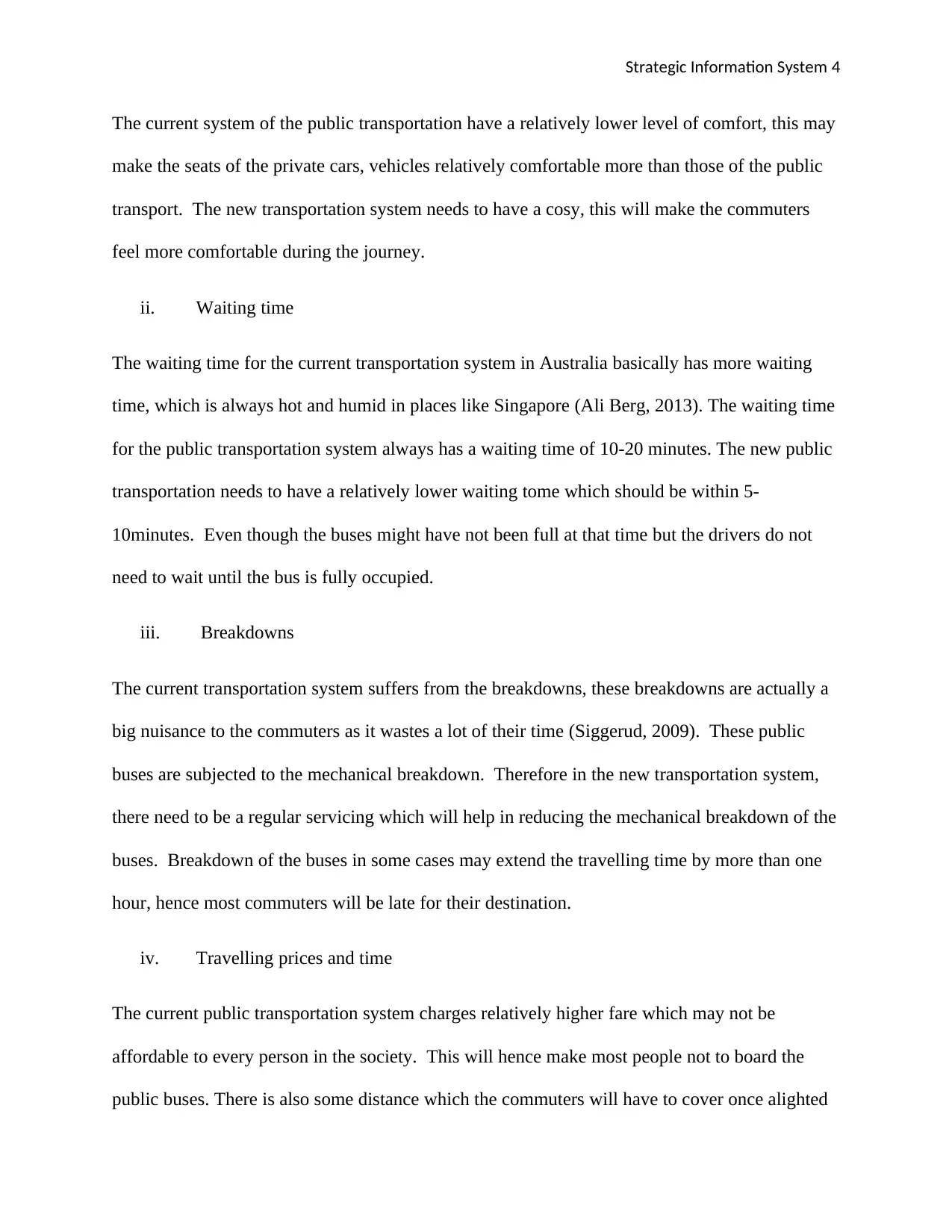
Strategic Information System 4
The current system of the public transportation have a relatively lower level of comfort, this may
make the seats of the private cars, vehicles relatively comfortable more than those of the public
transport. The new transportation system needs to have a cosy, this will make the commuters
feel more comfortable during the journey.
ii. Waiting time
The waiting time for the current transportation system in Australia basically has more waiting
time, which is always hot and humid in places like Singapore (Ali Berg, 2013). The waiting time
for the public transportation system always has a waiting time of 10-20 minutes. The new public
transportation needs to have a relatively lower waiting tome which should be within 5-
10minutes. Even though the buses might have not been full at that time but the drivers do not
need to wait until the bus is fully occupied.
iii. Breakdowns
The current transportation system suffers from the breakdowns, these breakdowns are actually a
big nuisance to the commuters as it wastes a lot of their time (Siggerud, 2009). These public
buses are subjected to the mechanical breakdown. Therefore in the new transportation system,
there need to be a regular servicing which will help in reducing the mechanical breakdown of the
buses. Breakdown of the buses in some cases may extend the travelling time by more than one
hour, hence most commuters will be late for their destination.
iv. Travelling prices and time
The current public transportation system charges relatively higher fare which may not be
affordable to every person in the society. This will hence make most people not to board the
public buses. There is also some distance which the commuters will have to cover once alighted
The current system of the public transportation have a relatively lower level of comfort, this may
make the seats of the private cars, vehicles relatively comfortable more than those of the public
transport. The new transportation system needs to have a cosy, this will make the commuters
feel more comfortable during the journey.
ii. Waiting time
The waiting time for the current transportation system in Australia basically has more waiting
time, which is always hot and humid in places like Singapore (Ali Berg, 2013). The waiting time
for the public transportation system always has a waiting time of 10-20 minutes. The new public
transportation needs to have a relatively lower waiting tome which should be within 5-
10minutes. Even though the buses might have not been full at that time but the drivers do not
need to wait until the bus is fully occupied.
iii. Breakdowns
The current transportation system suffers from the breakdowns, these breakdowns are actually a
big nuisance to the commuters as it wastes a lot of their time (Siggerud, 2009). These public
buses are subjected to the mechanical breakdown. Therefore in the new transportation system,
there need to be a regular servicing which will help in reducing the mechanical breakdown of the
buses. Breakdown of the buses in some cases may extend the travelling time by more than one
hour, hence most commuters will be late for their destination.
iv. Travelling prices and time
The current public transportation system charges relatively higher fare which may not be
affordable to every person in the society. This will hence make most people not to board the
public buses. There is also some distance which the commuters will have to cover once alighted
Paraphrase This Document
Need a fresh take? Get an instant paraphrase of this document with our AI Paraphraser
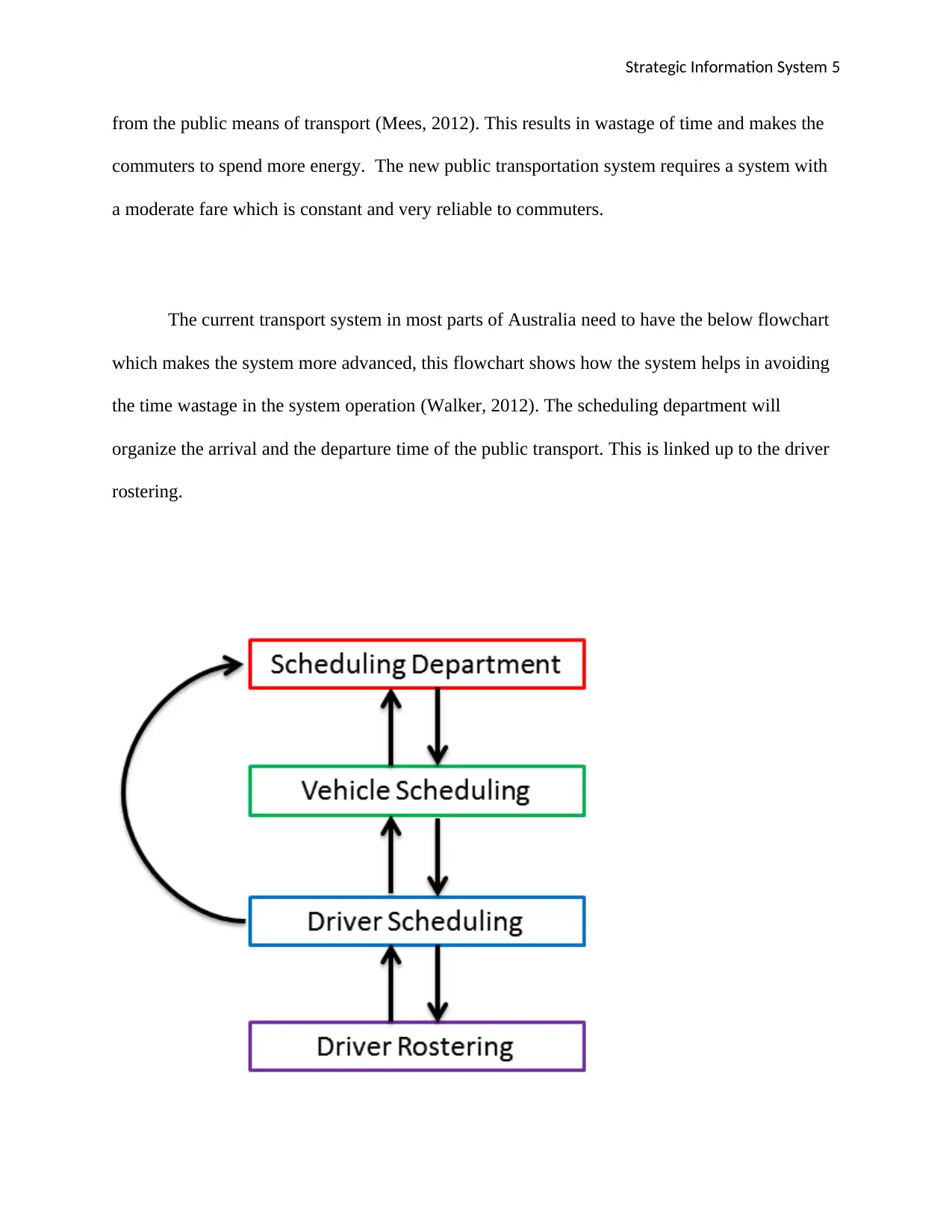
Strategic Information System 5
from the public means of transport (Mees, 2012). This results in wastage of time and makes the
commuters to spend more energy. The new public transportation system requires a system with
a moderate fare which is constant and very reliable to commuters.
The current transport system in most parts of Australia need to have the below flowchart
which makes the system more advanced, this flowchart shows how the system helps in avoiding
the time wastage in the system operation (Walker, 2012). The scheduling department will
organize the arrival and the departure time of the public transport. This is linked up to the driver
rostering.
from the public means of transport (Mees, 2012). This results in wastage of time and makes the
commuters to spend more energy. The new public transportation system requires a system with
a moderate fare which is constant and very reliable to commuters.
The current transport system in most parts of Australia need to have the below flowchart
which makes the system more advanced, this flowchart shows how the system helps in avoiding
the time wastage in the system operation (Walker, 2012). The scheduling department will
organize the arrival and the departure time of the public transport. This is linked up to the driver
rostering.
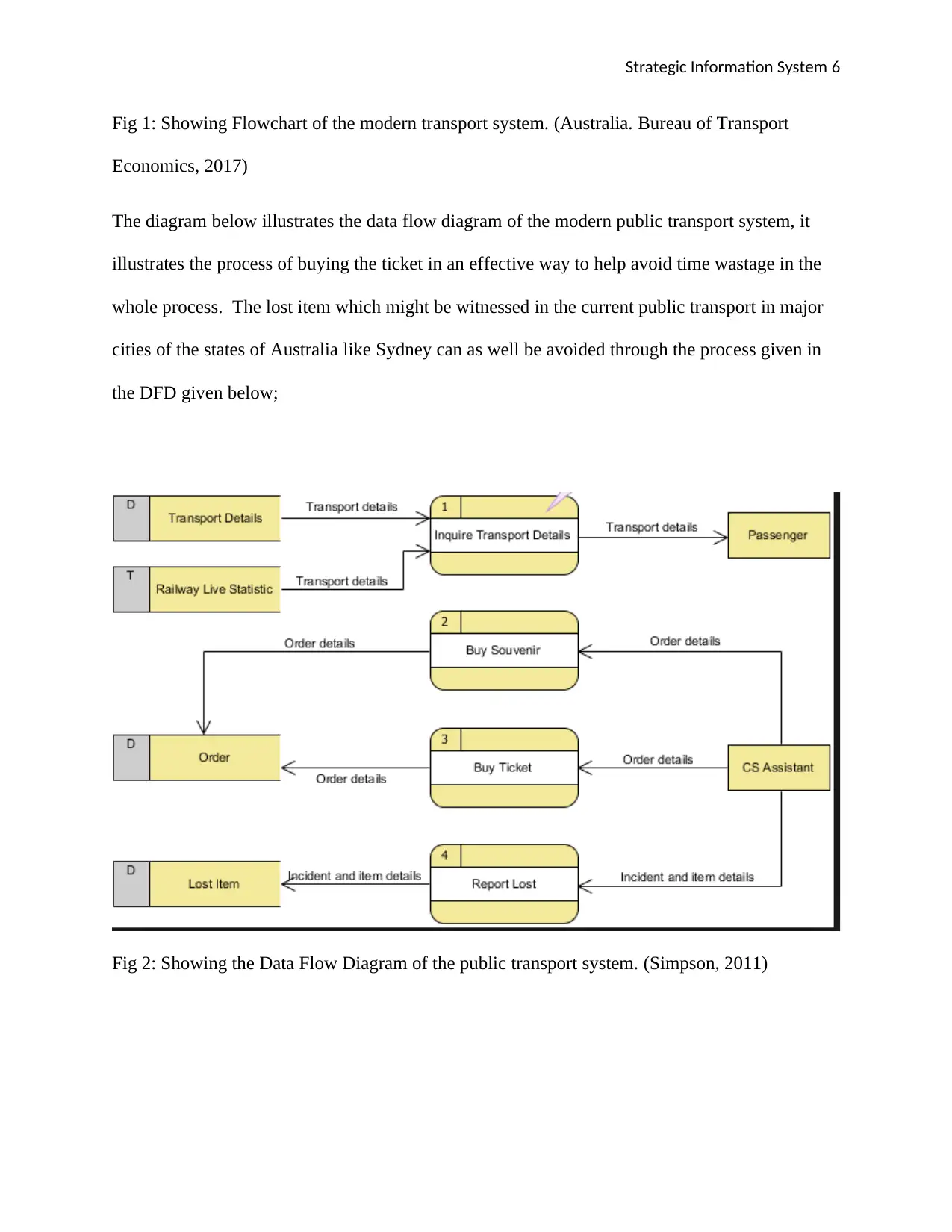
Strategic Information System 6
Fig 1: Showing Flowchart of the modern transport system. (Australia. Bureau of Transport
Economics, 2017)
The diagram below illustrates the data flow diagram of the modern public transport system, it
illustrates the process of buying the ticket in an effective way to help avoid time wastage in the
whole process. The lost item which might be witnessed in the current public transport in major
cities of the states of Australia like Sydney can as well be avoided through the process given in
the DFD given below;
Fig 2: Showing the Data Flow Diagram of the public transport system. (Simpson, 2011)
Fig 1: Showing Flowchart of the modern transport system. (Australia. Bureau of Transport
Economics, 2017)
The diagram below illustrates the data flow diagram of the modern public transport system, it
illustrates the process of buying the ticket in an effective way to help avoid time wastage in the
whole process. The lost item which might be witnessed in the current public transport in major
cities of the states of Australia like Sydney can as well be avoided through the process given in
the DFD given below;
Fig 2: Showing the Data Flow Diagram of the public transport system. (Simpson, 2011)
⊘ This is a preview!⊘
Do you want full access?
Subscribe today to unlock all pages.

Trusted by 1+ million students worldwide
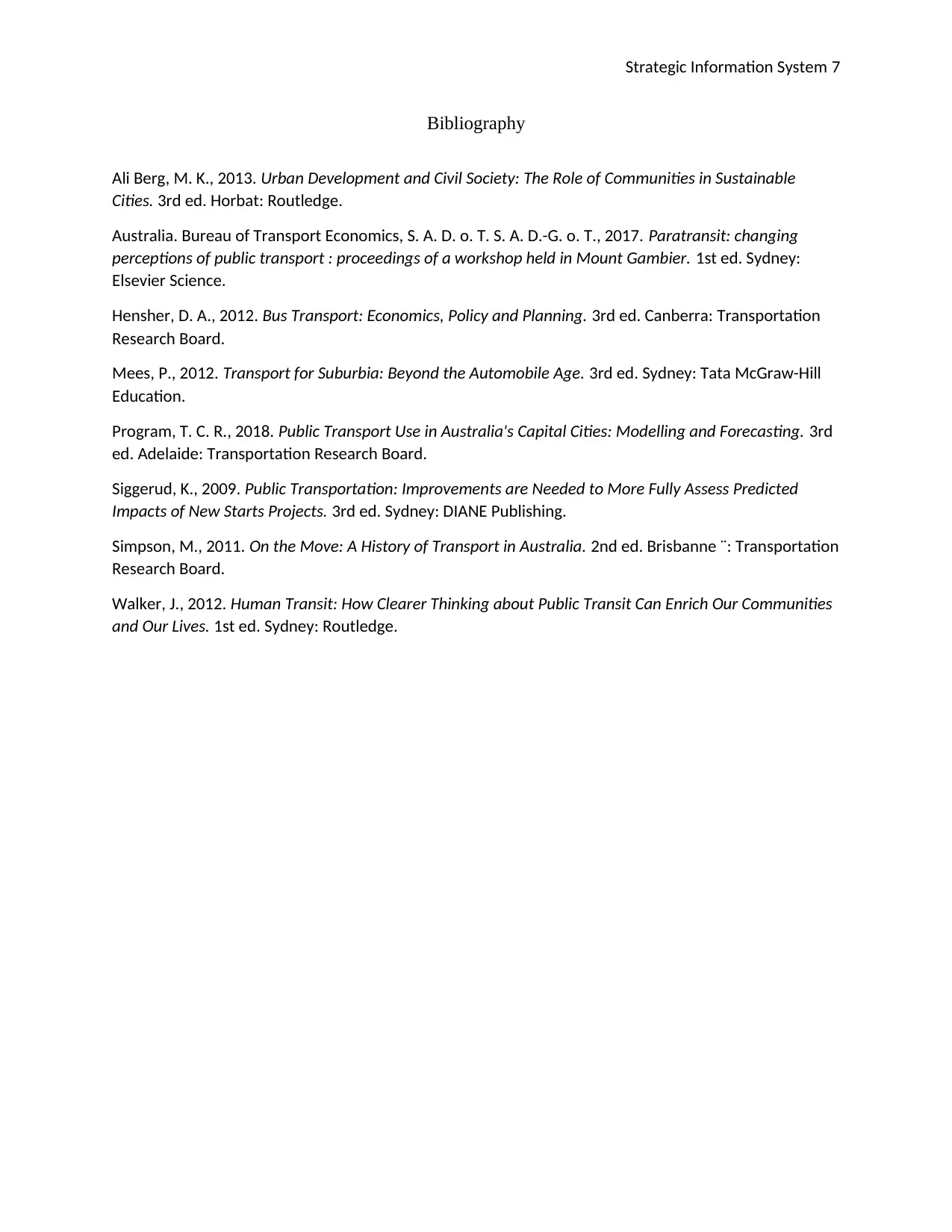
Strategic Information System 7
Bibliography
Ali Berg, M. K., 2013. Urban Development and Civil Society: The Role of Communities in Sustainable
Cities. 3rd ed. Horbat: Routledge.
Australia. Bureau of Transport Economics, S. A. D. o. T. S. A. D.-G. o. T., 2017. Paratransit: changing
perceptions of public transport : proceedings of a workshop held in Mount Gambier. 1st ed. Sydney:
Elsevier Science.
Hensher, D. A., 2012. Bus Transport: Economics, Policy and Planning. 3rd ed. Canberra: Transportation
Research Board.
Mees, P., 2012. Transport for Suburbia: Beyond the Automobile Age. 3rd ed. Sydney: Tata McGraw-Hill
Education.
Program, T. C. R., 2018. Public Transport Use in Australia's Capital Cities: Modelling and Forecasting. 3rd
ed. Adelaide: Transportation Research Board.
Siggerud, K., 2009. Public Transportation: Improvements are Needed to More Fully Assess Predicted
Impacts of New Starts Projects. 3rd ed. Sydney: DIANE Publishing.
Simpson, M., 2011. On the Move: A History of Transport in Australia. 2nd ed. Brisbanne ¨: Transportation
Research Board.
Walker, J., 2012. Human Transit: How Clearer Thinking about Public Transit Can Enrich Our Communities
and Our Lives. 1st ed. Sydney: Routledge.
Bibliography
Ali Berg, M. K., 2013. Urban Development and Civil Society: The Role of Communities in Sustainable
Cities. 3rd ed. Horbat: Routledge.
Australia. Bureau of Transport Economics, S. A. D. o. T. S. A. D.-G. o. T., 2017. Paratransit: changing
perceptions of public transport : proceedings of a workshop held in Mount Gambier. 1st ed. Sydney:
Elsevier Science.
Hensher, D. A., 2012. Bus Transport: Economics, Policy and Planning. 3rd ed. Canberra: Transportation
Research Board.
Mees, P., 2012. Transport for Suburbia: Beyond the Automobile Age. 3rd ed. Sydney: Tata McGraw-Hill
Education.
Program, T. C. R., 2018. Public Transport Use in Australia's Capital Cities: Modelling and Forecasting. 3rd
ed. Adelaide: Transportation Research Board.
Siggerud, K., 2009. Public Transportation: Improvements are Needed to More Fully Assess Predicted
Impacts of New Starts Projects. 3rd ed. Sydney: DIANE Publishing.
Simpson, M., 2011. On the Move: A History of Transport in Australia. 2nd ed. Brisbanne ¨: Transportation
Research Board.
Walker, J., 2012. Human Transit: How Clearer Thinking about Public Transit Can Enrich Our Communities
and Our Lives. 1st ed. Sydney: Routledge.
1 out of 7
Related Documents
Your All-in-One AI-Powered Toolkit for Academic Success.
+13062052269
info@desklib.com
Available 24*7 on WhatsApp / Email
![[object Object]](/_next/static/media/star-bottom.7253800d.svg)
Unlock your academic potential
Copyright © 2020–2025 A2Z Services. All Rights Reserved. Developed and managed by ZUCOL.




